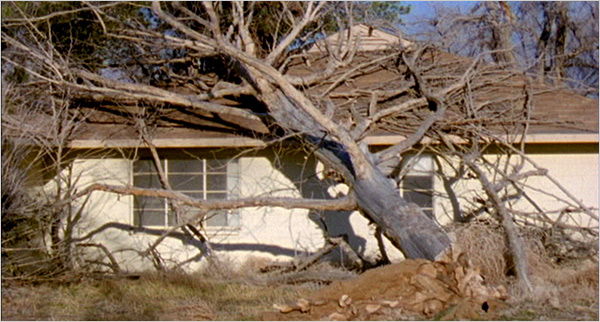
Movie Review: California Company Town
Utopia never looked so empty in the documentary California Company Town, which visits places that once were communities, many built around factories, and around once-shared hopes to create a new kind of society.
Lee Anne Schmitts camera lingers on these sites, post Gold Rush country, absent of activity as far as the eye can see. Nothing but memories, that is – and the longer the camera observes, the more you tend to fill in the blanks, as Schmidt relays a series of histories.
Her voiceover alternates between excerpts from political speeches by leaders on the Right and pep talks from religious radio. If thats not emptiness, I dont know what is.
The often-desert landscapes share a forlornness with the large-format banal-chic photographs that appeared all over art fairs and galleries several years ago. As with the movies subject, California towns like Chester and Scotia, the photographic style has come and gone. Schmitts moving pictures barely move, driving her point home.
Schmitt shifts back and forth between austere emptiness and stunning beauty, as her archaeological anti-travelogue takes you to towns that were settled when a company decided that money could be made, and abandoned when that money wasnt enough.
In Chester, you see the effects of mechanized logging on a town in the midst of a vast privately owned forest. In Scotia, the last company town in California, Pacific Lumber (Palco) is in bankruptcy and unloading houses.
Manzanar, California, was the site of an internment camp for Japanese-Americans. Now deserted, the barren site was a desert apple orchard at the foot of a mountain range.
An official voice track from the 1940s sets the scene: “We are setting new a standard for the rest of the world In the treatment of people who may have loyalties to an enemy nation. We are protecting ourselves without violating the principals of Christian decency.”
In Palmdale, where settlers in the high desert held “rabbit run” marches to drive rabbits in front of them before clubbing thousands of them to death, the former military town is now demarcated by security fences. Outside town are the windswept ruins of a cooperative settlement founded by the first socialist to run for mayor of Los Angeles.
Over footage of identical houses from the late 1950s, we hear Ronald Reagans voice deploring an elected officials use of the term, “the masses” – thats not how Americans see themselves, declared the Great Communicator. Yet thats certainly how the companies that laid out these vast settlements saw them.
This documentary, shot over five years, chronicles history rising and falling, where land and people were disposable.
Who lives in these places today?
Now they are the repositories for low-wage workers from Los Angeles, Palm Springs and other places that ordinary people cant afford. The land once ruled by boom companies is now the promised land of the sub-prime mortgage. (perhaps the title to the sequel should be California Finance Company Town.) And were told that Eagle Mountain, built by Kaiser Steel in 1948 and abandoned in 1984, could come to life again, as a site for the dumping of garbage from Los Angeles, which has exhausted its current trash sites. Now thats a selling point.
It could be worse. California City, imagined as a city that would equal Los Angeles some day, is now the site of the largest private prison in the state. Theres not much else nearby.
Watching California Company Town, you find echoes from Visual Acoustics, The Modernism of Julius Shulman, Eric Brickers documentary about the photographer whose pictures popularized American modernism, who spent the last decades of his long life deploring what industry had done to the California landscape. When he died last month, we were left wondering who might continue his work, or build on it. California Company Town, obtainable from leeanneschmitt@gmail.com This e-mail address is being protected from spambots. You need JavaScript enabled to view it , adds another chapter to the states visual history.
